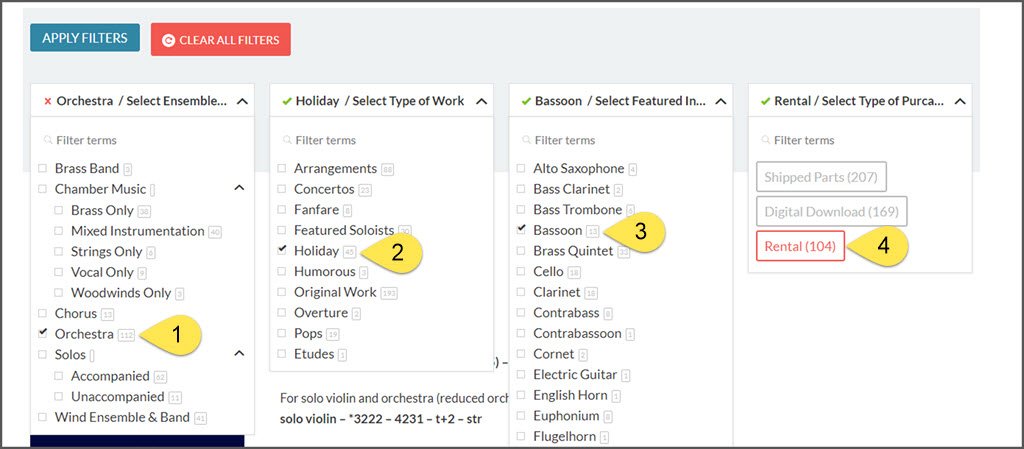There’s nothing quite like working on a project where you really get to push some boundaries and break out of the old trying to catch up by going slower routine.
Case in point, I launched a new Venture user website this week for composer Jim Stephenson. If you aren’t already familiar with Jim’s work, it’s amazing. He’s the next big thing when it comes to living composers. But I digress, this post is about user experience (UX).
For composers like Jim, one of the primary challenges is to make an otherwise unwieldy music catalog easy for users to navigate. What I mean by unwieldy is in addition to a lot of works (more than 250!), there are multiple variations of the same work. There are so many that the final count comes in at just over 1,000 purchasable options.
For example, his chamber ensemble work, Mahogany Moods, is available for Saxophone, Bass Trombone, and Piano; Viola, Bass Trombone, and Piano; Saxophone, Bass Clarinet, and Piano; and Viola, Bass Clarinet, and Piano. Oh, and each one can be purchased as a digital download or shipped print parts. That’s eight different options for the same chamber work.
Then there are the larger works, like the Holiday piece Bassoon It Will Be Christmas. It’s available in both Wind Ensemble and Orchestra versions plus a piano reduction. You get the picture.
More Than Just Variations
Typically, a simple variation structure can handle those sorts of differences but it comes up short when you start to take the bigger UX picture into consideration. Sure, classical music buyers are used to having things divided up into traditional categories like chamber music, chorus, orchestra, solos, band, etc.
But after interviewing a few dozen types (individuals, small ensembles, Pro-Am, organization, etc.) it became clear that we needed to consider a complete architecture redesign that included several types of taxonomy meta (the little bits of data that help search and filter tools work).
Each buyer placed different value on searchable taxonomy. But designing the UX for one group at the expense of the other wasn’t an option.
Here’s what we determined as the best approach:
- Create a brand-new taxonomy structure capable of providing improved content management and organization for both admins and buyers.
- Organize works using a series of categories, tags, and attributes which, in turn, are used by frontend users to filter and search.
Those guidelines ended up producing three primary types of taxonomy. Each work and variation has two or more of these classifications assigned:
- Ensemble/Solo Type: these contain many of the traditional ways to categorize music; i.e. chamber music, choral, orchestral, solos, band, etc.
- Type of Work: arrangements, original works, concertos, fanfares, features soloists, holiday, overtures, pops, etc.
- Featured Instruments: this is used to denote works that either present one or more instrument in a solo spotlight as well as assigning primary instrumentation for chamber and small ensemble works.
The second tier of taxonomy were very buyer driven values:
- Type of Purchase: rentals, printed/shipped parts, and those with versions available for digital download.
- Duration: allows users to filter results based on min/max lengths.
Turning Everything Into Product Filters
Each of those taxonomy types has its own filter on the website product pages. We also added the ability for users to set fewer/greater number of results per page, filter works that are Jim’s special picks, and a good old-fashioned keyword search field.
Ultimately, we ended up with eight filters plus a toggle for users to display results in a grid or list format:
If you want to search for “holiday” music written for “orchestra” that features “bassoons,” and is available for “rental” you can do that. Or how about cut the bassoons and focus on something between 3-10 minutes long. No problem; in fact, there are 38 works that fall into that filter range.
Both searches took seconds to complete. Simple, intuitive, and elegant regardless which type of buyer you are.
It’s worth pointing out that during the initial research phase of the project, it struck me as odd that even though using something like an ecommerce product filter seemed like a no-brainer, no one else out there was doing it.
We examined more than 70 composer and publisher websites and the only thing that came closer were two music retail websites. Even then, their filtering was limited to half the number of options we worked into this project.
But Wait, Filtering Was Only The Beginning
Users had very clear lists of pet-peeves and must-haves for how works should be displayed. Simply put, they were adamant about having this information right on list pages; i.e. they didn’t want to click into each individual work’s page and get stuck in some back and forth rubbernecking purgatory. Here all the items we needed to fit into a tight footprint for each work:
- audio clips
- detailed instrumentation for large ensemble works
- variation options
- duration
- sample PDF scores
This helped tremendously when it came time to designing the excerpted product views for the list pages.
It Always Comes Down To Parent/Child Relationships
The final nut to crack circles back to grouping all the different variations of a work into a way that is easily managed. This is a much tougher problem when looking at it from the admin side of the fence but there were some key UX issues as well.
The solution we uncovered was to forego old-school ecommerce product variations and opt for a Parent/Child group relationship (just like any good Verdi libretto).
- Each work exists as a parent level product. It includes the full description, videos, audio clips, cover images, excerpt view, and most of the taxonomy are assigned at this level.
- Each purchasable variation became a unique child product. Pricing and downloadable files were assigned here.
This parent/child relationship makes it super easy for the admins to update pricing and to add or remove variations. This structure also makes it easier for buyers to add multiple variations to their cart all from the same screen. Because really, how annoying is it to add a score only, then go back to the product and add the parts, then go back again for something else. Who has that much time?
The parent/child grouping also made it easy to set up their rental structure, which charges an initial fee for the first show then discounted rates for additional performances. This means a buyer can rent a work for three performances and order the piano reduction all from one screen.
Without Willing Clients, None Of This Would Happen
I would be remiss if I didn’t point out how much time and effort these clients put into the project.
As I pointed out at the beginning, you can’t catch up by going slower…but that doesn’t make all the requisite sprinting any easier!
Simply put, upgrading their entire music catalog and wading through the mountain of categorization and content entry is not for the faint of heart. To that end, both Jim and (especially) his wife Sally deserve a tremendous amount of kudos for jumping into what was otherwise unknown territory to them at the beginning.
Everything we covered here is only part of the overall project. You can read a more comprehensive overview at the site’s user profile page or simply jump right in at ComposerJim.com for a first-hand experience.
So, which composer or publisher out there wants to be next?







